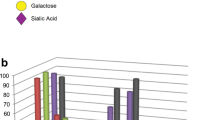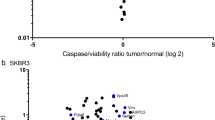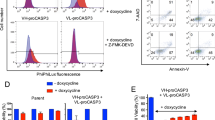Abstract
We studied several monoclonal antibodies (mAbs) raised against the 100 kD Ras GTPase activating protein (p100–GAP), which was purified from human placenta. These antibodies recognized p120–GAP and p100–GAP in native and in denatured forms. The most reactive, GP15 and GP200, both recognized distinct epitopes and did not neutralize GTPase stimulatory activity. These two mAbs were selected for a two–site enzyme immunoassay, using covalent conjugates of the antibodies coupled to the tetrameric form of acetylcholinesterase as tracer. This assay was used to quantify Ras–GAP in both normal and tumor tissues and cell extracts.
This is a preview of subscription content, access via your institution
Access options
Subscribe to this journal
Receive 12 print issues and online access
$209.00 per year
only $17.42 per issue
Buy this article
- Purchase on Springer Link
- Instant access to full article PDF
Prices may be subject to local taxes which are calculated during checkout
Similar content being viewed by others
References
Bourne, H.R., Sanders, D.A. and McCormick, F. 1991. GTPase superfamily: conserved structure and molecular mechanism. Nature 349: 117–127.
Paterson, H., Reeves, B., Brown, R., Hall, A., Furth, M., Bos, J., Jones, P. and Marshall, C. 1987. Activated N-ras controls the transformed phenotype of HT1080 human fibrosarcoma cells. Cell 51: 803–812.
Trahey, M. and McCormick, F. 1987. A cytoplasmic protein stimulates normal N-ras p21 GTPase, but does not affect oncogenic mutants. Science 238: 542–545.
Wolfman, A. and Macara, I. 1990. A cytosolic protein catalyzes the release of GDP from p2l ras . Science 248: 67–69.
Downward, J., Reihl, R., Wu, L. and Weinberg, R.A. 1990. Identification of a nucleotide exchange-promoting activity for p21 ras . Proc. Natl. Acad. Sci. USA 87: 5998–6002.
Tsai, M., Yu, C. and Stacey, D.W. 1990. A cytoplasmic protein inhibits the GTPase activity of H-ras in a phospholipid-dependent manner. Science 250: 982–985.
Vogel, U.S., Dixon, R.A.F., Schaber, M.D., Diehl, R.E., Marshall, M.S., Scolnick, E.M., Sigal, I.S. and Gibbs, J.B. 1988. Cloning of bovine GAP and its interaction with oncogenic ras p21. Nature 335: 90–93.
Gibbs, J.B., Schaber, M.D., Allard, W.J., Sigal, I.S. and Scolnick, E.M. 1988. Purification of ras GTPase activating protein from bovine brain. Proc. Natl Acad. Sci. USA 85: 5026–5030.
Trahey, M., Wong, G., Halenbeck, R., Rubinfeld, B., Martin, G.A., Ladner, M., Long, C.M., Crosier, W.J., Watt, K., Koths, K. and McCormick, F. 1988. Molecular cloning of two types of GAP complementary DNA from human placenta. Science 242: 1697–1700.
Xu, G., OConnell, P., Viskochil, D., Cawthon, R., Robertson, M., Culver, M., Dunn, D., Stevens, J., Gesteland, R., White, R. and Weiss, R. 1990. The neurofibromatosis type 1 gene encodes a protein related to GAP. Cell 62: 599–608.
Martin, G.A., Viskochil, D., Bollag, G., McCabe, P.C., Crosier, W.J., Haubruck, H., Conroy, L., Clark, R., O'Connell, P., Cawthon, R.M., Innis, M.A. and McCormick, F. 1990. The GAP-related domain of the neurofibromatosis type 1 gene product interacts with ras p21. Cell 63: 843–849.
Ballester, R., Marchuk, D., Boguski, M., Saulino, A., Letcher, R., Wigler, M. and Collins, F. 1990. The NF1 locus encodes a protein functionally related to mammalian GAP and yeast IRA proteins. Cell 63: 851–859.
Tanaka, K., Nakafuku, M., Satoh, T., Marshall, M.S., Gibbs, J.B., Matsumoto, K., Kaziro, Y. and Toh-e, A. 1990. S. cerevisiae genes IRA1 and IRA2 encode proteins that may be functionally equivalent to mammalian ras GTPase activating protein. Cell 60: 803–807.
Tanaka, K., Lin, B.K., Wood, D.R. and Tamanoi, F. 1991. IRA2, an upstream negative regulator of RAS in yeast, is a RAS GTPase-activating protein. Proc. Natl. Acad. Sci. USA 88: 468–472.
Cales, C., Hancock, J.F., Marshall, C.J. and Hall, A. 1988. The cytoplasmic protein GAP is implicated as the target for the regulation by the ras gene product. Nature 332: 548–551.
Adari, H., Lowy, D.R., Willumsen, B.M., Red, C.J. and McCormick, F. 1988. Guanosine triphosphatase activating protein (GAP) interacts with the p21 ras effector binding domain. Science 240: 518–521.
Yatani, A., Okabe, K., Polakis, P., Halenbeck, R., McCormick, F. and Brown, A.M. 1990. ras p21 and GAP inhibit coupling of muscarinic receptors to atrial K+ channels. Cell 61: 769–776.
Martin, G.A., Yatani, A., Clark, R., Conroy, L., Polakis, P., Brown, A.M. and McCormick, F. 1991. GAP domains responsible for ras p21-dependent inhibition of muscarinic atrial K+ channel currents. Science 255: 192–194.
Dominguez, I., Marshall, M.S., Gibbs, J., GarciadeHerreros, A., Cornet, M.E., Graziani, G., Diaz-Meco, M.T., Johansen, T., McCormick, F. and Moscat, J. 1991. Role of GTPase activating protein in mitogenic signalling through phosphatidylcholine-hydrolysing phospholipase C. EMBO J. 10: 3215–3220.
Chung, D.L., Brandtrauf, P., Murphy, R.B., Nishimura, S., Yamaizumi, Z., Weinstein, I.B. and Pincus, M.R. 1991. A peptide from the GAP-binding domain of the ras-p21 protein as well as azatyrosine block ras-induced maturation of Xenopus oocytes. Biochem. Biophys. Res. Commun. 181: 1378–1384.
Nishi, T., Lee, P.S.Y., Oka, K., Levin, V.A., Tanase, S., Morino, Y. and Saya, H. 1991. Differential expression of two types of the neurofibromatosis type-1 (NF1) gene transcripts related to neuronal differentiation. Oncogene 6: 1555–1559.
Anderson, D., Koch, C.A., Grey, L., Ellis, C., Moran, M.F. and Pawson, T. 1990. Binding of SH2 domains of phospholipase Cγ1, GAP, and Src to activated growth factor receptors. Science 250: 979–985.
Zhang, K., DeClue, J.E., Vass, W.C., Papageorge, A.G., McCormick, F. and Lowy, D.R. 1990. Suppression of c-ras transformation by GTPase-activating protein. Nature 346: 754–756.
Mayer, B., Jackson, P.K. and Baltimore, D. 1991. The noncatalytic src homology region 2 segment of abl tyrosine kinase binds to tyrosine-phosphorylated cellular proteins with high affinity. Proc. Natl. Acad. Sci. USA 88: 627–631.
Brott, B.K., Decker, S., OBrien, M.C. and Jove, R. 1991. Molecular features of the viral and cellular Src kinases involved in interactions with the GTPase-activating protein. Mol. Cell. Biol. 11: 5059–5067.
DeClue, J.E., Zhang, K., Redford, P., Vass, W.C. and Lowy, D.R. 1991. Suppression of src transformation by overexpression of full-length GTPase-activating protein (GAP) or of the GAP C terminus. Mol. Cell. Biol. 11: 2819–2825.
Nori, M., Vogel, U.S., Gibbs, J.B. and Weber, M.J. 1991. Inhibition of v-src-induced transformation by a GTPase-activatin protein. Mol. Cell. Biol. 11: 2812–2818.
Bollag, G. and McCormick, F. 1991. Differential regulation of rasGAP and neurofibromatosis gene product activities. Nature 351: 576–579.
Cichowski, K., McCormick, F. and Brugge, J.S. 1992. p21 ras GAP association with Fyn, Lyn, and Yes in thrombin-activated platelets. J. Biol. Chem. 267: 5025–5028.
Reinstein, J., Schlichting, I., Frech, M., Goody, R.S. and Wittinghofer, A. 1991. p21 with a phenylalanine 28 — > leucine mutation reacts normally with the GTPase activating protein GAP but nevertheless has transforming properties. J. Biol. Chem. 266: 17700–17706.
Caruelle, D., Grassi, J., Courty, J., Groux-Muscatelli, B., Pradelles, P., Barritault, D. and Caruelle, J.P. 1988. Development and testing of radio and enzyme immunoassays for acidic fibroblast growth factor (aFGF). Anal. Biochem. 173: 328–339.
Grassi, J., Frobert, Y., Lamourette, P. and Lagoutte, B. 1988. Screening of monoclonal antibodies using antigens labelled with acetylcholinesterase: Application to the peripheral proteins of photosystem 1. Anal. Biochem. 168: 436–450.
Grassi, J., Frobert, Y., Pradelles, P., Chercuite, F., Gruaz, D., Dayer, J.M. and Poubelle, P.E. 1989. Production of monoclonal antibodies against interleukins 1α and 1β Development of two enzyme immunometric assays using acetylcholinesterase and their application to biological media. J. Immunol. Methods. 123: 193–210.
Halenbeck, R., Crosier, W.J., Clark, R., McCormick, F. and Koths, K. 1990. Purification, characterization, and Western blot analysis of human GTPase-activating protein from native and recombinant sources. J. Biol. Chem. 265: 21922–21928.
Boone, C., Sasaki, M. and McKee, W. 1965. Characterization of an in vitro strain of Ehrlich-Lettre ascites carcinoma subjected to many periodic mouse passages. J. Natl. Cancer Inst. 43: 725–740.
Schneider, C., Newman, R.A., Sutherland, D.R., Asser, U. and Greaves, M.F. 1982. A one step purification of membrane proteins using a high efficiency immunomatrix. J. Biol. Chem. 257: 10766–10769.
Ellman, G.L., Courtney, K.D., Andres, V. and Featherstone, R.M. 1961. A new and rapid colorimetric determination of acetylcholinesterase activity. Biochem. Pharmacol. 7: 88–95.
Pradelles, P., Grassi, J. and Maclouf, J. 1985. Enzyme immunoassays of eicosanoids using acetylcholinesterase as label. Anal. Chem. 57: 1170–1173.
Reik, L.M., Maines, S.L., Ryan, D.E., Levin, W., Bandiera, S. and Thomas, P.E. 1987. A simple, non-chromatographic purification procedure for monoclonal antibodies. Isolation of monoclonal antibodies against cytochrome P450 isozymes. J. Immunol. Methods 100: 123.
Larue, C., Chateigner, C., Gautier, P., Planchenault, J. and Leger, J. 1988. Optimisation of mouse IgG fragmentation techniques in the selection of monoclonal antibodies for myocardial infarct imaging, 129–138. In: Radiolabeled Monoclonal Antibodies for Imaging and Therapy. Srivastava, S. C. (Ed.). Plenum Publishing, London, UK.
Author information
Authors and Affiliations
Rights and permissions
About this article
Cite this article
Mollat, P., Zhang, G., Frobert, Y. et al. Non–Neutralizing Monoclonal Antibodies Against RAS GTPase–Activating Protein: Production, Characterization and Use in an Enzyme Immunometric Assay. Nat Biotechnol 10, 1151–1156 (1992). https://doi.org/10.1038/nbt1092-1151
Received:
Accepted:
Issue Date:
DOI: https://doi.org/10.1038/nbt1092-1151



